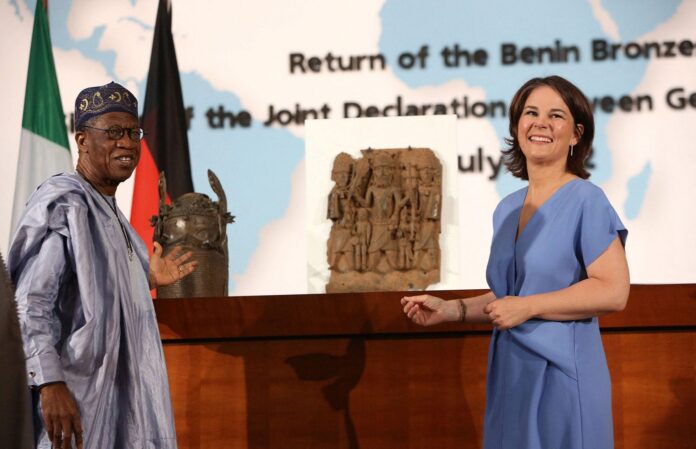To date, accounts of cultural restitution have predominantly been a story about Western institutions, told from the West’s perspective. The protagonists are benevolent European and North American organisations, whose virtue is manifest in their return of colonial looted objects “for free”. The focus of Western media on this “decolonisation” has given rise to a growing set of photo opportunities, accompanied by lengthy interviews with Western curators, followed by a few words of gratitude from “representatives of Nigeria”.
When the same media lens momentarily shifts to Nigeria, it does so only to find inadequacy. “Chaos” and “fiasco” are among the milder word choices. To these commentators, it seems fine for the West to take more than a hundred years to begin to act on restitution, but unforgivable that Nigeria does not resolve complex domestic and historical issues instantaneously.
Objects were taken from a kingdom that is now part of a state and a country that did not exist at the time they were removed. Government agencies have been established and regulation adopted concerning artefacts of national importance. There are delicate balances and overlapping responsibilities between federal, state and community leadership that need to be managed, and are far more nuanced than the Western press reports. There should be debate and disagreement about what is the most appropriate outcome. This is only natural and will take time to fully resolve.

The contemporary art fair Art X Lagos was launched in 2016 to provide a platform for artists from Africa and its diaspora. According to Phillip Ihenacho, it is vital that West Africa develops an infrastructure to support the region’s vibrant contemporary art community Emmanuel Arewa/AFP via Getty Images
From the viewpoint of the institution we are developing in Nigeria, the Museum of West African Art in Edo State, there is a vital need for the narrative of the restitution of the Benin bronzes to be told from the perspective of Africans, based on the realities on the ground. Yes, Nigerians are grateful for the West’s finally considering the return of objects, and in particular for the considerable courage shown by the German government. But we have lost much more than artworks and artefacts.
In 1897, when the British razed Benin City and carried off thousands of Benin bronzes, Nigeria was deprived of a great collection of objects with religious, historical and cultural significance. But events such as this also accelerated the loss of a long tradition of support infrastructure and disrupted manufacturing systems for arts and culture. In ancient days, the Royal Palace of Benin was a great patron of the arts with the resources of the sovereign supporting more than 40 craft and professional guilds. The Benin bronzes were a direct consequence of the palace’s support for artisans, artists and heritage professionals.
With the weakening of the traditional kingdoms, followed by years of less-than-satisfactory leadership in Nigeria, there has been a tragic underinvestment in arts and culture, with young artists, artisans, curators, archaeologists and art historians being starved of support and career opportunities. Nigeria today suffers a profound (albeit partly self-inflicted) deficit in platforms and programmes to showcase, support and research arts, artisanship and creativity.
Earn confidence and respect
Our museum’s mission is to begin to address this loss of cultural infrastructure in West Africa, while working collaboratively with the rightful owners of art and artefacts, and is not to chase after restituted objects in our own right. We may hold, study, conserve and exhibit West African artefacts, including restituted Benin bronzes, but we do so only with the permission of the owners and authorities. As a new independent charitable trust, we must earn the confidence and respect of the relevant stakeholders through actions and not just words. But even as we work toward this goal and the negotiations on restitution continue, there is plenty for us to do.
Nigeria and wider West Africa are blessed with an abundance of cultural history and artefacts already in the region, as well as a vibrant contemporary arts community, which needs infrastructure for research, display, learning and exchange. Developing this infrastructure is our first priority. In today’s Nigeria, where approximately 70% of our population (of more than 200 million people) is under the age of 30, we must create infrastructure and programmes that uplift and inspire young creatives and cultural professionals, and enhance career opportunities as a core part of our mission. As and when restituted objects may be entrusted to us, they will be welcomed as part of a much broader centre, where they will be seen side by side with contemporary and Modern works of art to inspire the next generation of great West African creatives. Our museum complex will be defined by the needs and opportunities in present-day West Africa, not by romantic notions of the West.
We must not forget that as Africans, we are situated at a pivotal moment in arts and culture. Despite the current need for infrastructure and support, our music, literature, art, architecture and film are beginning to thrive and connect with global audiences. At the same moment, many Western institutions are seeking “restitution” or atonement for the colonial past. We must ensure that the term “restitution” is shaped by us, and is not just about artefacts and victimhood, but also about creating opportunities, networks and skill sets for the present and the future, so young African creatives can compete globally. We must mobilise resources from both domestic and international sources to reconnect great artistic traditions of the past to talented contemporary creative professionals, and create points of equal exchange between the rest of the world and Africa that benefit creative minds on both sides.
Our museum complex seeks to create an ecosystem to support the preservation and research of past culture and artefacts, but also, more importantly, to provide infrastructure for learning and exchange, skill-building and career-enhancement opportunities for contemporary creatives, artisans and heritage professionals. This is our restitution and our core objective.

























